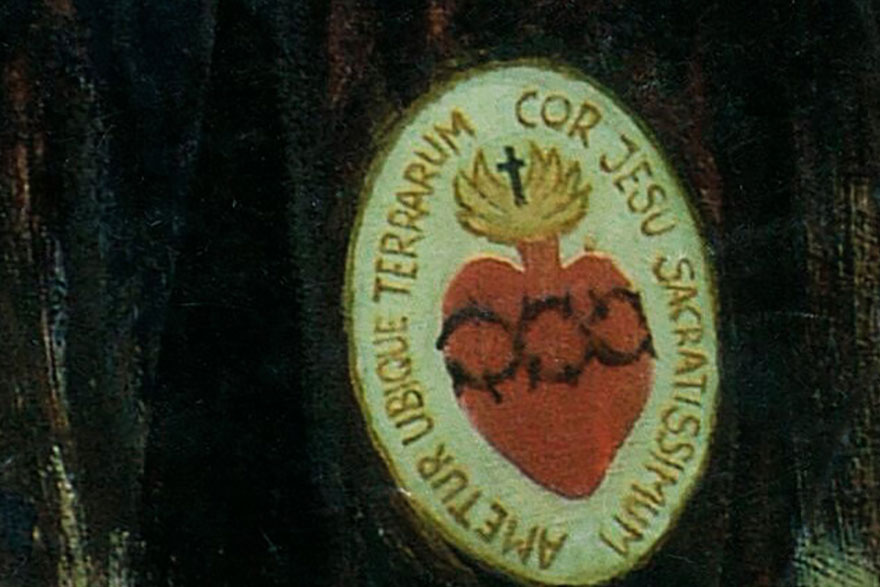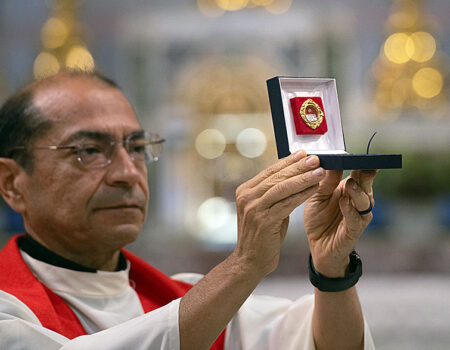Reflection: ‘Ut in ipso vivas, et regnes in perpetuum’
Thursday December 26, 2024

“That you may live and reign in him forever and ever”.
‘Ut in ipso vivas, et regnes in perpetuum‘ (’that you may live and reign in him forever and ever”), thus ends the hymn proper to the Missionaries of the Sacred Heart called Ave Admirabile, through which the religious consecrate themselves daily to the Sacred Heart. In the light of the latest encyclical published by Pope Francis, entitled Dilexit nos (Rom 8:37), i.e. ‘he loved us’, we realise how the charism and spirituality given to Father Jules Chevalier (1824-1907), for the good of the Church and all humanity, is current and necessary today.
Starting from this excerpt from Ave Admirabile, which echoes and deepens the request of the Our Father prayer, that is, ‘Your Kingdom come’, we find a similarity and a rapprochement with number 182 of the aforementioned encyclical, since the Holy Father writes, quoting Saint John Paul II, of the need to build a civilisation of love, which in reality is the Kingdom of the Heart of Christ. In this way, when we ask that the Heart of Jesus live and reign in our hearts, we express our desire to be guided by the sentiments of that Heart (cf. Phil 2:5) so that his Kingdom may come and fertilise humanity.
Also, in number 166, starting from the experiences and writings of St Margaret Mary, we find another approach. Francis signs that ‘Jesus speaks of his thirst to be loved’. The motto of the congregation of the Missionaries of the Sacred Heart is ‘May the Sacred Heart of Jesus be loved everywhere’. This is neither a coincidence nor a significant discovery since St Margaret’s writings influenced Fr. Chevalier. Therefore, in the apostolate, through witness and preaching, the members of this congregation (and all those who live this charism and spirituality, in other words, the members of the Chevalier Family) are called to make this Heart known and loved, starting from the certainty that ‘He first loved us’ (cf. 1 Jn 4:10).

From an intimate and profound experience with the Love of God, Fr. Jules Chevalier realised that the Sacred Heart was a remedy for the ills that afflicted the people of his time (MSC Const., 3). We can intuit that Jules Chevalier was a man who had his eyes fixed on the Lord and his Adorable Heart but who was also attentive and sensitive to the people and situations around him. In this sense, he is an example for us that ‘looking to the Lord, who “took our infirmities and carried our sorrows”, helps us to pay more attention to the suffering and needs of others’ (DILEXIT NOS, 171).
Returning to the theme of the Kingdom, the Constitutions of the MSC state that the mission of the Congregation of the Missionaries of the Sacred Heart is to work for the advent of the Kingdom of God (cf. Const, MSC, 27), in a combination of living the Spirituality of the Heart and commitment to our brothers and sisters, especially the marginalised and forgotten. The Constitutions of the Missionaries of the Sacred Heart state that ‘in the poor and the little ones, in all the victims of injustice and violence, we will discover the face of Christ’ (Const. MSC, 22). Francis, for his part, teaches that Jesus ‘changed the face of the world by giving life to institutions dedicated to caring for those in inhumane conditions: abandoned newborns, orphans, the elderly left alone, the mentally ill, those with incurable diseases or serious malformations, the homeless’ (DILEXIT NOS, 170).
For Fr Jules Chevalier, the figure of Mary was extremely important and necessary because of her role as intercessor, in the light of Jn 2:1-5 (Wedding at Cana). In this way, it’s interesting to touch on the Marian theme in Spirituality of the Heart and note a possible rapprochement with the new encyclical, since in Dilexit nos Francis states that ‘in the Church, the mediation of Mary, intercessor and mother, can only be understood as participation in this one source, which is the mediation of Christ himself’ (DILEXIT NOS, 176). From the outset, Fr Jules Chevalier wanted to honour and venerate Mary in a special way, so, under the impulse of the Spirit, he invoked Mary as Our Lady of the Sacred Heart, recognising that ‘Mary is intimately united to the mystery of the Heart of her Son’ (Const. MSC, 18). For the representation of the image, Jules Chevalier felt that it was necessary for the mother to be with the Son and for the Son to ‘show his Heart with one hand and point to his Mother with the other’ (cf. CHEVALIER). Mary’s relationship with the Heart of her Son is a profound and intimate one, because ‘she knew the unfathomable riches of Christ, she was filled with his love; she leads us to him by pointing to his Heart, the source of a boundless love that gives birth to a new world’ (MSC Const., 18). Mary leads everyone to the fountain that springs from the Heart of Jesus.
Finally, the beauty of the new encyclical, its spiritual value, is an invitation to all Christians to unite themselves to the Heart of Jesus, seeking to have the same feelings and thoughts that dwell in this Sacred Heart. For us, Missionaries of the Sacred Heart and members of the Chevalier Family, it is an impetus to continue living this charism and spirituality faithfully in the Church and in the world, proclaiming God’s love and mercy, calling for the coming of the Kingdom, knowing how to discern the signs of the times and the seeds planted by the Spirit in different situations and realities.
Leonardo Henrique Agostinho, MSC





